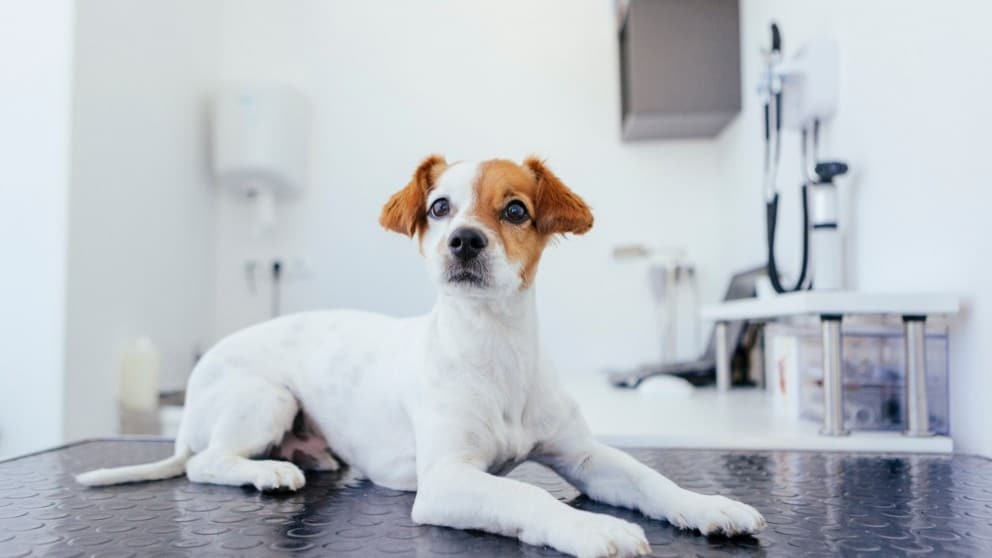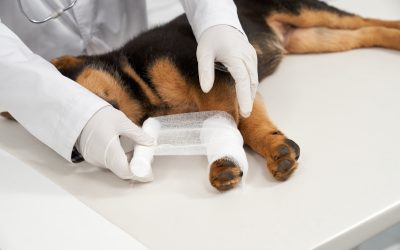Lymphoma in Dogs: Symptoms, Causes & Treatments

Introduction
Lymphoma is a significant and fairly prevalent form of cancer in dogs. It affects the lymphocytes, also known as white blood cells, which are the building blocks of the immune system. This article delves into the origins, indicators, methods of diagnosis, and available treatments for lymphoma in dogs. Understanding the importance of early detection and accurate diagnosis is extremely important, as lymphoma in dogs can progress rapidly if left untreated. With the right knowledge, pet owners can become proactive advocates for their furry friends and make informed decisions about their care.
What Is Lymphoma In Dogs?
Lymphoma, or lymphosarcoma, is a cancer variety that targets the lymphatic system in dogs. This system comprises a series of vessels and organs crucial for combating infections and diseases in the body. Lymphoma occurs when abnormal lymphocytes, a type of white blood cell, start to multiply uncontrollably.
What Are the Types of Lymphoma In Dogs?
Lymphoma in dogs manifests in various forms, each with distinct characteristics and implications for treatment. The most prevalent type is multicentric lymphoma, which affects lymph nodes throughout the body and often leads to visible swelling in multiple areas.
Beyond multicentric lymphoma, dogs may also experience other types, including:
- Mediastinal Lymphoma: This type affects the lymph nodes in the chest area, particularly those around the heart and lungs. Symptoms may include difficulty breathing, coughing, and lethargy.
- Gastrointestinal Lymphoma: In this form, lymphoma primarily affects the digestive system, including the stomach and intestines. Dogs with gastrointestinal lymphoma may display symptoms such as vomiting, diarrhea, weight loss, and decreased appetite.
- Cutaneous Lymphoma: Cutaneous lymphoma involves the skin and typically presents as lumps, lesions, or patches of irritated skin. It may resemble other skin conditions, making diagnosis challenging without proper veterinary evaluation.
Each type of lymphoma can vary in its clinical presentation and response to treatment. Therefore, veterinarians must accurately diagnose each type of lymphoma to tailor treatment plans effectively.
Although lymphoma can affect dogs of any age, breed, or gender, certain breeds, such as Golden Retrievers, Boxers, and Bullmastiffs, are considered to be at a higher risk. Early detection and prompt intervention remain crucial in managing this condition and improving the prognosis for affected dogs.
Symptoms of Lymphoma In Dogs
Symptoms of lymphoma in dogs can differ based on the disease’s type and progression stage. Typical indicators include enlarged lymph nodes detectable as subdermal lumps, weight reduction, diminished appetite, and fatigue. Additional symptoms might encompass heightened thirst and urination, breathing challenges, vomiting, diarrhea, and skin sores.

However, these signs could also stem from other ailments, so seeking a veterinarian’s expertise for precise diagnosis is essential. Prompt identification of lymphoma is crucial in securing the most favorable prognosis for your pet.
Diagnosing Lymphoma In Dogs
To diagnose lymphoma in dogs, veterinarians conduct a detailed physical exam and might suggest various tests. These tests often include bloodwork, such as a blood chemistry panel, to consider the dog’s general health and detect any irregularities. A biopsy from an impacted lymph node or organ is frequently required to confirm the diagnosis.
In certain situations, imaging tests like X-rays, ultrasound, or CT scans are utilized to gauge the disease’s spread and to formulate an effective treatment strategy. Additionally, the veterinarian might advise procedures such as bone marrow or lymph node aspiration to examine the cancer cells more closely.
Treatment Options For Lymphoma In Dogs
After confirming a lymphoma diagnosis, the subsequent action is to review treatment alternatives with your veterinarian. The treatment’s objective is to attain remission, where the cancer becomes undetectable, and to enhance the dog’s quality of life.
Chemotherapy, involving drugs that attack and destroy cancer cells, is the primary treatment method for lymphoma in dogs. The specific chemotherapy protocol can differ based on the lymphoma type, stage, and the dog’s overall health condition.
Treatment can be administered orally, intravenously, or through other methods and usually requires multiple sessions over several months.
Chemotherapy For Lymphoma In Dogs
Chemotherapy drugs used to treat lymphoma in dogs include cyclophosphamide, doxorubicin, vincristine, prednisone, and others. These drugs work by disrupting the growth and division of cancer cells, ultimately leading to their destruction. Although chemotherapy may lead to side effects like nausea, vomiting, and reduced immunity, most dogs handle the treatment effectively.
Throughout the chemotherapy period, routine check-ups and blood tests are essential to track the dog’s reaction to the therapy and to modify the medication as required. The length of the chemotherapy course varies depending on the dog’s response and the lymphoma stage.
Radiation Therapy For Lymphoma In Dogs
Radiation therapy might be advised in some instances of lymphoma, particularly when the disease is confined to a specific area like the skin or a single lymph node. This therapy employs high-energy radiation beams to focus on and eliminate cancer cells and is usually administered in multiple sessions over several weeks.
Radiation therapy can be utilized either as a standalone treatment or in conjunction with chemotherapy, based on the individual circumstances. The choice to opt for radiation therapy hinges on several aspects, such as the lymphoma type, the cancer’s location, and dog’s overall health condition, and the recommendation from your veterinarian.
Surgery
Surgery is generally limited for lymphoma due to its systemic nature, but it might be employed in rare cases where a localized tumor is accessible and removable.
Immunotherapy
Immunotherapy is used as a supportive treatment option and aims to boost the dog’s immune system to fight cancer cells. It’s often used in combination with other treatments.
Alternative Treatments For Lymphoma In Dogs
Besides traditional methods like chemotherapy and radiation therapy, some pet owners might consider alternative or supplementary treatments for their dogs diagnosed with lymphoma. These therapies may include acupuncture, herbal supplements, dietary changes, and other holistic approaches.
It is important to consult with a veterinarian who specializes in integrative medicine or alternative therapies before pursuing alternative treatments. While some of these therapies may offer additional support and symptom relief, they should not be considered as a substitute for conventional treatments.
Cost of Treatment for Lymphoma In Dogs
The costs associated with treating lymphoma in dogs vary widely, depending on several factors, including the type and stage of cancer, the number of treatments required, and the dog’s age and condition. Here is a breakdown of the average cost ranges for each treatment option:
Chemotherapy
Chemotherapy is the treatment for canine lymphoma, and its cost ranges from $1,000 to $10,000, averaging around $5,000. Different chemotherapy protocols have varying costs. For example, L-asparaginase treatment is estimated at $1,500 for the first two treatments and $500 per treatment afterward.
Other chemotherapy drugs such as Tanovea (rabacfosadine) cost between $500-$800 per treatment, Mitoxantrone is estimated at $350-$450 per treatment, and Dacarbazine (DTIC) at around $500 per treatment.
Radiation Therapy
Radiation therapy typically ranges from $1000 to $6,000 for the entire treatment.The cost varies based on the number of treatments, typically ranging from 15-20 sessions over several weeks.
Surgery
Surgery costs for treating lymphoma in dogs can vary, and they include more than just the surgery itself. You’ve got follow-up care and other treatments to think about, too. And if the tumor is in a tricky spot, like really hard to reach, those costs might increase even more.
So, when you’re considering surgery for your furry friend’s lymphoma, it’s good to keep the bigger picture in mind. There’s the surgery, of course, but also things like check-ups before and after, any meds they might need, and maybe even some special care while they recover. Knowing all this upfront helps you plan and ensure your pup gets the care they need without surprises!
Immunotherapy
Treatment protocols involving immunotherapy drugs like L-asparaginase combined with prednisone cost between $300 to $400 per treatment.
It’s important to note that the initial visit for diagnosis and setting up a treatment plan can cost $200 and upwards. These costs can significantly vary based on geographic location, the specific needs of the dog, and the veterinary clinic. Additionally, ongoing expenses such as follow-up exams, blood work, and potential side effects management should be considered in the overall cost of treatment.
Prevention and Early Detection of Lymphoma In Dogs
While there is no guaranteed way to prevent lymphoma in dogs, there are some steps you can take to reduce the risk. Consistent veterinary examinations are crucial for monitoring your dog’s general health and identifying potential problems early, especially if your dog is a breed that is predisposed to lymphoma, annual preventative exams are critical. Detecting lymphoma at an early stage significantly enhances the likelihood of effective treatment. Provide a balanced diet, regular exercise, and a stress-free environment. Avoid exposure to potential carcinogens, such as secondhand smoke or certain chemicals.
How Can Pet Insurance Help?
Because cancer diagnosis and other medical costs can be costly, pet insurance helps ease the burden of these expenses. Odie Pet Insurance offsets the cost of injuries, illness, and preventative care for dogs.
Pet insurance gives you control over your budget without being burdened by unexpected vet bills. Odie Pet Insurance makes your pet’s medical care manageable. Odie’s offers several dog plans, so you can decide which fits your budget and your pet’s needs best.
Reimbursement
This method is the most common for pet insurance companies. You pay out of pocket for the veterinarian bill, and then the insurance company reimburses you for what’s covered under the insurance plan. The steps look like this.
- You pay the vet bill after your dog’s visit.
- You fill out the pet insurance claim form.
- Submit the claim form and other required documentation to the insurer.
- After the claim is approved, you will be reimbursed for eligible expenses.
Odie’s Pet Insurance Plans
Illness & Injury Plan
This insurance plan is Odie’s most comprehensive plan covering illness and injuries your dog may incur. This plan covers
- Emergency vet visits
- Surgeries
- Overnight hospital stays
- X-rays
- Prescription meds
- Lab tests
- And much more
Accident-Only Plan
Odie’s Accident-Only Plan covers wounds, injuries, and vet treatments, including X-rays, Ultrasounds, tests, and emergency care your sweet pet might need if they accidentally get injured.
Wellness Plan
This add-on plan guarantees you can keep your dog up to date on their vaccinations, heartworm checks, and other routine checks.
Prognosis and Life Expectancy For Dogs With Lymphoma
The outlook for dogs diagnosed with lymphoma depends on various elements, such as the type and stage, the dog’s age and general health, and the selected treatment method. When lymphoma is detected early and treated properly, many dogs can reach remission and experience an extended period of high-quality life. Consistent examinations and vigilant monitoring are essential to maintain the continued health and well-being of dogs diagnosed with lymphoma.
Conclusion
Lymphoma in dogs is a complex and challenging disease, but with the right knowledge and proactive approach, pet owners can make informed decisions about their dog’s care. Early detection, accurate diagnosis, and appropriate treatment are key to improving the prognosis and quality of life for dogs with lymphoma.
Consulting with a veterinarian specializing in oncology or internal medicine is essential for developing a personalized treatment plan that considers the dog’s specific needs. Advances in veterinary medicine have made significant progress in treating lymphoma in dogs, offering hope for a brighter future for our furry companions.
By staying informed and advocating for our dogs, we can navigate the lymphoma world and ensure our beloved pets receive the best possible care. Let’s work together towards a future where lymphoma is no longer a devastating diagnosis but a manageable condition that can be successfully treated.
*Updated May 16, 2024




